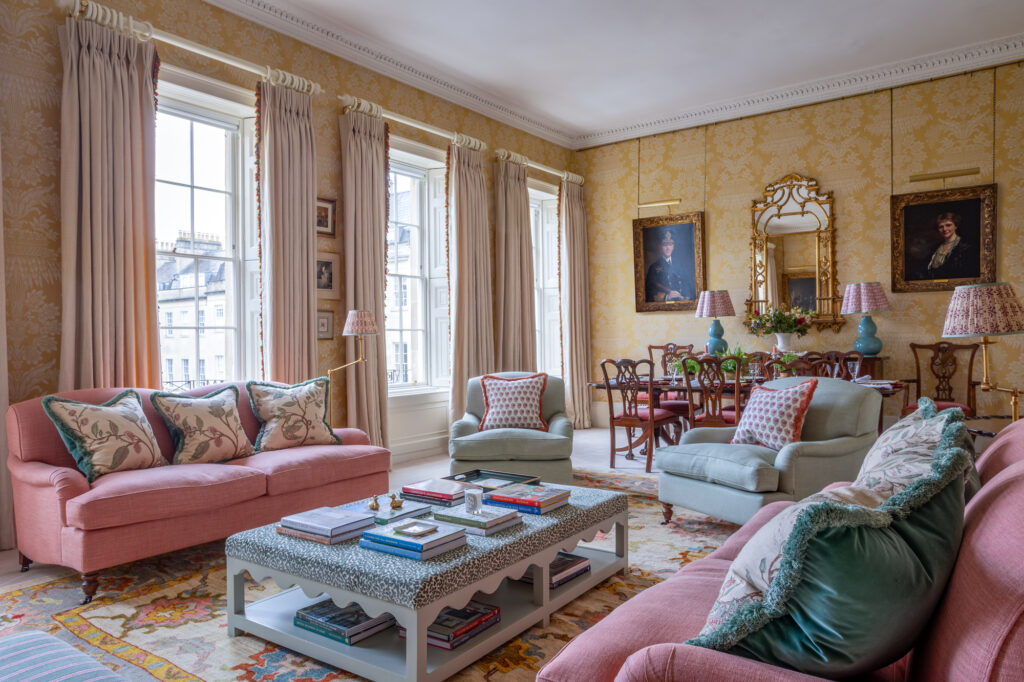
As interior designers in Bath, we’ve had the privilege of working with some of the city’s most beautiful historic properties. These architectural treasures, with their distinctive honey-coloured stone and elegant Georgian proportions, present unique challenges that require a delicate balance of preservation and modern living.
Understanding the Framework
Before diving into any listed property project, we always take time to understand the specific grade and its implications. Grade I and II listings aren’t just accolades, they’re protective frameworks that shape every decision we make. Working with Bath’s planning authorities has taught us that early consultation and clear communication are essential for project success.
The Window Dilemma
One of the most common challenges we face as interior designers Bath residents trust is working with original windows. Those beautiful sash windows that give Bath homes their distinctive character often come with issues like drafts and heat loss. While complete replacement is rarely an option, we’ve found creative solutions using discrete draft-proofing systems and well-designed window dressings that complement rather than compete with the original architecture.
Modern Heating Solutions
Integrating modern heating systems into listed properties requires particular finesse. Original features like ornate cornicing and historic fireplaces need to be preserved, which often means thinking creatively about radiator placement. We’ve found success with underfloor heating in certain areas, particularly in basement conversions, while in other spaces, we work with specialist manufacturers who create radiators that complement Georgian interiors.
Bathroom Design
When planning your home renovation in Bath, bathrooms often present the biggest challenge in listed properties. Modern plumbing needs to work around original joists and structural elements that can’t be altered. We’ve developed expertise in creating luxurious bathrooms that respect the building’s heritage – sometimes using existing chimney stacks for soil pipes or creating false walls that protect original features while concealing modern necessities.
Lighting the Way
Lighting requires a particularly thoughtful approach in listed properties. Original rooms were designed for candlelight, not modern lighting schemes. We often layer different light sources – combining discrete architectural lighting with decorative fixtures that complement the period. Picture lights for original features, hidden LED strips behind cornicing, and carefully placed table lamps can transform a space while respecting its heritage.
Kitchen Considerations
Bath interior designers frequently face the challenge of creating modern kitchens in historic settings. Original kitchen spaces were often in basements or separate from main living areas – not ideal for contemporary living. We’ve found success in designing kitchens that use freestanding elements rather than fitted units where possible, allowing original walls to remain visible. When built-in elements are necessary, we often create them as ‘furniture pieces’ that complement the property’s period.
Storage Solutions
Georgian properties weren’t designed with modern storage needs in mind. Creating adequate storage while preserving original features requires creative thinking. We often design bespoke joinery that appears original to the property, utilising awkward spaces and creating hidden storage behind panelling. The key is to make these additions feel like they’ve always been part of the house.
Colour and Decoration
While there’s often pressure to stick to historically accurate colour schemes, we believe listed properties can embrace contemporary colour choices while respecting their heritage. The key is understanding how light works in these spaces — Georgian windows create particular lighting conditions that affect how colour is perceived. We often work with specialist paint manufacturers who understand period properties and can create colours that enhance original features.
Technology Integration
Modern technology needs careful integration in listed properties. We’ve become adept at finding ways to incorporate everything from wireless charging points to home automation systems without compromising historical integrity. Sometimes this means creating custom furniture pieces that house technology or finding innovative ways to hide cables within existing architectural features or embracing the additions in a classic way — think a classic brass conduit to hide a wall light wire.
Bringing It All Together
The most successful listed property renovations happen when there’s a clear understanding between all parties – homeowners, designers, conservation officers, and craftspeople. We’ve found that starting with a comprehensive survey and documentation of original features helps inform every decision moving forward. It’s about creating spaces that work for modern living while celebrating the unique character of these extraordinary buildings.
Looking Forward
As specialists in historic properties, we’re constantly developing new approaches to common challenges. Every listed property project teaches us something new about balancing preservation with modern needs. The key is remaining flexible and creative while always respecting the building’s heritage.
Remember, working with a listed property is a privilege – you’re not just creating a home, you’re becoming part of the building’s ongoing story. With thoughtful design and careful consideration, these properties can continue to be wonderful family homes for generations to come, while preserving the unique architectural heritage that makes Bath such a special place.
